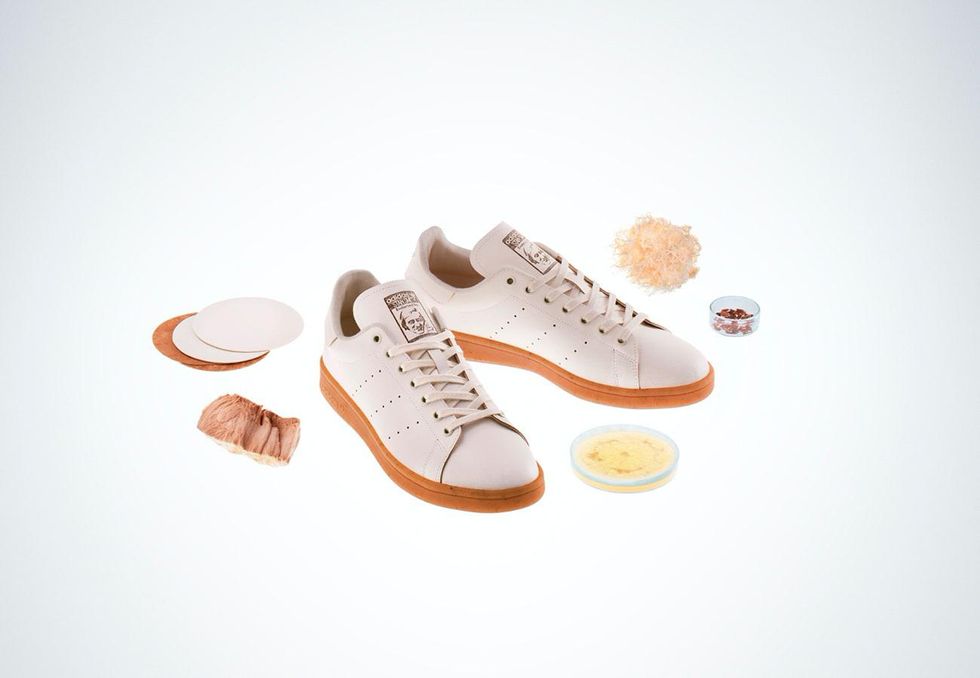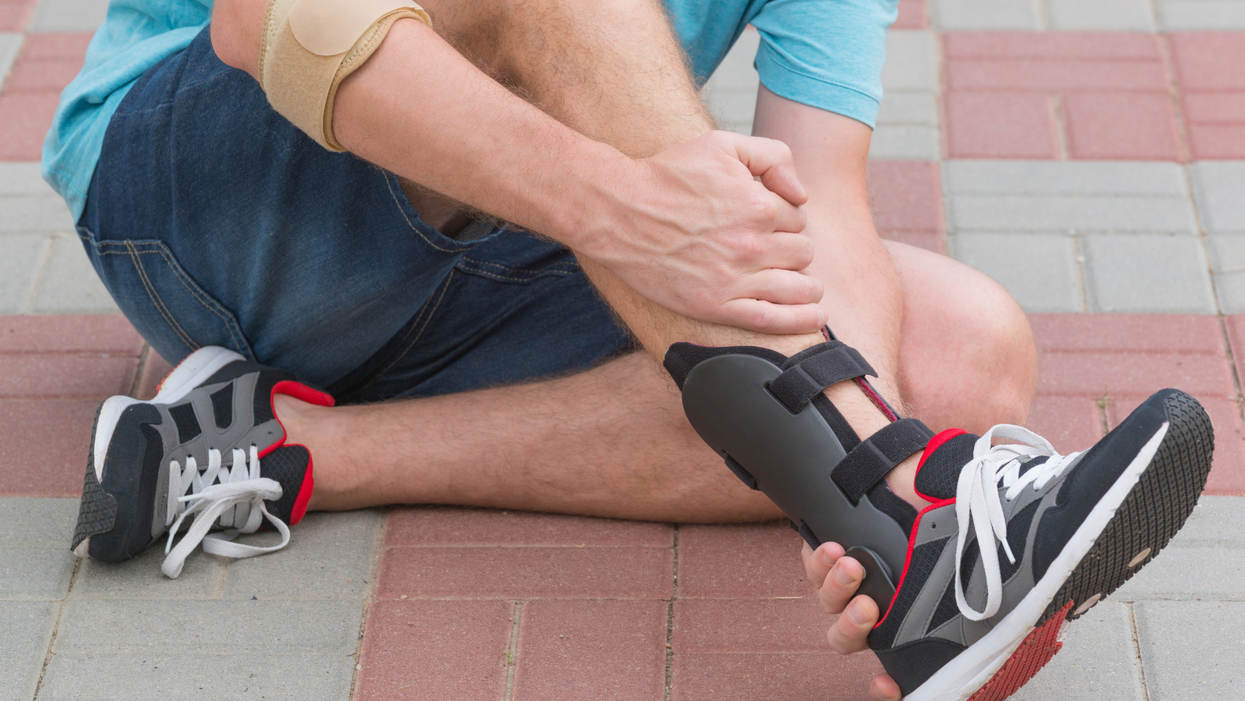Fungus is the ‘New Black’ in Eco-Friendly Fashion

On the left, a Hermès bag made using fine mycelium as a leather alternative, made in partnership with the biotech company MycoWorks; on right, a sheet of mycelium "leather."
A natural material that looks and feels like real leather is taking the fashion world by storm. Scientists view mycelium—the vegetative part of a mushroom-producing fungus—as a planet-friendly alternative to animal hides and plastics.
Products crafted from this vegan leather are emerging, with others poised to hit the market soon. Among them are the Hermès Victoria bag, Lululemon's yoga accessories, Adidas' Stan Smith Mylo sneaker, and a Stella McCartney apparel collection.

The Adidas' Stan Smith Mylo concept sneaker, made in partnership with Bolt Threads, uses an alternative leather grown from mycelium; a commercial version is expected in the near future.
Adidas
Hermès has held presales on the new bag, says Philip Ross, co-founder and chief technology officer of MycoWorks, a San Francisco Bay area firm whose materials constituted the design. By year-end, Ross expects several more clients to debut mycelium-based merchandise. With "comparable qualities to luxury leather," mycelium can be molded to engineer "all the different verticals within fashion," he says, particularly footwear and accessories.
More than a half-dozen trailblazers are fine-tuning mycelium to create next-generation leather materials, according to the Material Innovation Initiative, a nonprofit advocating for animal-free materials in the fashion, automotive, and home-goods industries. These high-performance products can supersede items derived from leather, silk, down, fur, wool, and exotic skins, says A. Sydney Gladman, the institute's chief scientific officer.
That's only the beginning of mycelium's untapped prowess. "We expect to see an uptick in commercial leather alternative applications for mycelium-based materials as companies refine their R&D [research and development] and scale up," Gladman says, adding that "technological innovation and untapped natural materials have the potential to transform the materials industry and solve the enormous environmental challenges it faces."
In fewer than 10 days in indoor agricultural farms, "we grow large slabs of mycelium that are many feet wide and long. We are not confined to the shape or geometry of an animal."
Reducing our carbon footprint becomes possible because mycelium can flourish in indoor farms, using agricultural waste as feedstock and emitting inherently low greenhouse gas emissions. Carbon dioxide is the primary greenhouse gas. "We often think that when plant tissues like wood rot, that they go from something to nothing," says Jonathan Schilling, professor of plant and microbial biology at the University of Minnesota and a member of MycoWorks' Scientific Advisory Board.
But that assumption doesn't hold true for all carbon in plant tissues. When the fungi dominating the decomposition of plants fulfill their function, they transform a large portion of carbon into fungal biomass, Schilling says. That, in turn, ends up in the soil, with mycelium forming a network underneath that traps the carbon.
Unlike the large amounts of fossil fuels needed to produce styrofoam, leather and plastic, less fuel-intensive processing is involved in creating similar materials with a fungal organism. While some fungi consist of a single cell, others are multicellular and develop as very fine threadlike structures. A mass of them collectively forms a "mycelium" that can be either loose and low density or tightly packed and high density. "When these fungi grow at extremely high density," Schilling explains, "they can take on the feel of a solid material such as styrofoam, leather or even plastic."
Tunable and supple in the cultivation process, mycelium is also reliably sturdy in composition. "We believe that mycelium has some unique attributes that differentiate it from plastic-based and animal-derived products," says Gavin McIntyre, who co-founded Ecovative Design, an upstate New York-based biomaterials company, in 2007 with the goal of displacing some environmentally burdensome materials and making "a meaningful impact on our planet."
After inventing a type of mushroom-based packaging for all sorts of goods, in 2013 the firm ventured into manufacturing mycelium that can be adapted for textiles, he says, because mushrooms are "nature's recycling system."
The company aims for its material—which is "so tough and tenacious" that it doesn't require any plastic add-on as reinforcement—to be generally accessible from a pricing standpoint and not confined to a luxury space. The cost, McIntyre says, would approach that of bovine leather, not the more upscale varieties of lamb and goat skins.
Already, production has taken off by leaps and bounds. In fewer than 10 days in indoor agricultural farms, "we grow large slabs of mycelium that are many feet wide and long," he says. "We are not confined to the shape or geometry of an animal," so there's a much lower scrap rate.
Decreasing the scrap rate is a major selling point. "Our customers can order the pieces to the way that they want them, and there is almost no waste in the processing," explains Ross of MycoWorks. "We can make ours thinner or thicker," depending on a client's specific needs. Growing materials locally also results in a reduction in transportation, shipping, and other supply chain costs, he says.
Yet another advantage to making things out of mycelium is its biodegradability at the end of an item's lifecycle. When a pair of old sneakers lands in a compost pile or landfill, it decomposes thanks to microbial processes that, once again, involve fungi. "It is cool to think that the same organism used to create a product can also be what recycles it, perhaps building something else useful in the same act," says biologist Schilling. That amounts to "more than a nice business model—it is a window into how sustainability works in nature."
A product can be called "sustainable" if it's biodegradable, leaves a minimal carbon footprint during production, and is also profitable, says Preeti Arya, an assistant professor at the Fashion Institute of Technology in New York City and faculty adviser to a student club of the American Association of Textile Chemists and Colorists.
On the opposite end of the spectrum, products composed of petroleum-based polymers don't biodegrade—they break down into smaller pieces or even particles. These remnants pollute landfills, oceans, and rivers, contaminating edible fish and eventually contributing to the growth of benign and cancerous tumors in humans, Arya says.
Commending the steps a few designers have taken toward bringing more environmentally conscious merchandise to consumers, she says, "I'm glad that they took the initiative because others also will try to be part of this competition toward sustainability." And consumers will take notice. "The more people become aware, the more these brands will start acting on it."
A further shift toward mycelium-based products has the capability to reap tremendous environmental dividends, says Drew Endy, associate chair of bioengineering at Stanford University and president of the BioBricks Foundation, which focuses on biotechnology in the public interest.
The continued development of "leather surrogates on a scaled and sustainable basis will provide the greatest benefit to the greatest number of people, in perpetuity," Endy says. "Transitioning the production of leather goods from a process that involves the industrial-scale slaughter of vertebrate mammals to a process that instead uses renewable fungal-based manufacturing will be more just."
An Investigational Drug Offers Hope to Patients with a Disabling Neuromuscular Disease
Robert Thomas was a devoted runner, gym goer, and crew member on a sailing team in San Diego when, in his 40s, he noticed that his range of movement was becoming more limited.
He thought he was just getting older, but when he was hiking an uphill trail in Lake Tahoe, he kept tripping over rocks. "I'd never had this happen before," Robert says. "I knew something was wrong but didn't know what it was."
It wasn't until age 50 when he was diagnosed with Charcot-Marie-Tooth disease. The genetic disorder damages the peripheral nerves, which connect the brain and spinal cord to the rest of the body. This network of nerves is responsible for relaying information and signals about sensation, movement, and motor coordination. Over time, the disease causes debilitating muscle weakness and the loss of limb control.
Charcot-Marie-Tooth usually presents itself in childhood or in a person's teens, but in some patients, like Robert, onset can be later in life. Symptoms may include muscle cramping, tingling, or burning. Many patients also have high foot arches or hammer toes — toes that curl from the middle joint instead of pointing forward. Those affected often have difficulty walking and may lose sensation in their lower legs, feet, hands, or forearms. One of the most common rare diseases, it affects around 130,000 people in the United States and 2.8 million worldwide.
Like many people with Charcot-Marie-Tooth, or CMT, Robert wears corrective braces on his legs to help with walking. Now 61, he can't run or sail anymore because of the disease, but he still works out regularly and can hike occasionally. CMT also affects his grip, so he has to use special straps while doing some exercises.
For the past few years, Robert has been participating in a clinical trial for an investigational CMT drug. He takes the liquid formulation every morning and evening using an oral syringe. Scientists are following patients like Robert to learn if their symptoms stabilize or improve while on the drug. Dubbed PXT300, the drug was designed by French biopharmaceutical company Pharnext and is the farthest along in development for CMT. If approved, it would be the first drug for the disease.
Currently, there's no cure for CMT, only supportive treatments like pain medication. Some individuals receive physical and occupational therapy. A drug for CMT could be a game-changer for patients whose quality of life is severely affected by the disease.
Genetic Underpinnings
CMT arises from mutations in genes that are responsible for creating and maintaining the myelin sheath — the insulating layer around nerves. Pharnext's drug is meant to treat patients with CMT1A, the most common form of the disease, which represents about half of CMT cases. Around 5% of those with CMT1A become severely disabled and end up in wheelchairs. People with CMT1A have an extra copy of the gene PMP22, which makes a protein that's needed to maintain the myelin sheath around peripheral nerves.
Typically, an individual inherits one copy of PMP22 from each parent. But a person with CMT1A receives a copy of PMP22 from one parent and two copies from a parent with the disease. This extra copy of the gene results in excess protein production, which damages the cells responsible for preserving and regenerating the myelin sheath, called Schwann cells.
The myelin sheath helps ensure that a signal from the brain gets carried to nerves in the muscles so that a part of the body can carry out a particular action or movement. This sheath is like the insulation on an electrical cord and the action is like a light bulb. If the insulation is fine, the light bulb turns on. But if the insulation is frayed, the light will flicker.
"The same happens to these patients," says David Horn Solomon, CEO of Pharnext. "The signal to their muscle is weak and flickers." Over time, their muscles become weaker and thinner.
The PMP22 gene has proven difficult to target with a drug because it's located in a protected space — the Schwann cells that make up the insulation around nerves. "There's not an easy way to tamp it down," Solomon says.
Another company, Acceleron Pharma of Cambridge, Massachusetts, was developing an injectable CMT drug meant to increase the strength of leg muscles. But the company halted development last year after the experimental drug failed in a mid-stage trial. While the drug led to a statistically significant increase in muscle volume, it didn't translate to improvements in muscle function or quality of life for trial participants.
Made by Design
Pharnext's drug, PXT3003, is a combination of three existing drugs — baclofen, a muscle relaxant; naltrexone, a drug that decreases the desire for alcohol and opioids; and sorbitol, a type of sugar alcohol.
The company designed the drug using its artificial intelligence platform, which screened 20,000 existing drugs to predict combinations that could inhibit the PMP22 gene and thereby lower protein production. The AI system narrowed the search to several hundreds of combinations and Pharnext tested around 75 of them in the lab before landing on baclofen, naltrexone, and sorbitol. Individually, the drugs don't have much effect on the PMP22 gene. But combined, they work to lower how much protein the gene makes.
"How the drug inside the cell reduces expression isn't quite clear yet," says Florian Thomas, director of the Hereditary Neuropathy Center, and founding chair and professor in the department of neurology at Hackensack University Medical Center and Hackensack Meridian School of Medicine in New Jersey (no relation to Robert Thomas, the CMT patient). "By reducing the amount of protein being produced, we hopefully can stabilize the nerves."
In rodents genetically engineered to have the PMP22 gene, the drug reduced protein levels and delayed onset of muscle weakness when given to rats. In another animal study, the drug increased the size of the myelin sheath around nerves in rats.
"Like humans with CMT, one of the problems the animals have is they can't grip things, their grip strength is poor," Solomon says. But when treated with Pharnext's drug, "the grip strength of these animals improves dramatically even over 12 weeks."
Human trials look encouraging, too. But the company ran into a manufacturing issue during a late-stage trial. The drug requires refrigeration, and as a result of temperature changes, crystals formed inside vials containing the high dose of the drug. The study was a double-blind trial, meaning neither the trial participants nor investigators were supposed to know who received the high dose of the drug, who received the low dose, and who received a placebo. In these types of studies, the placebo and experimental drug should look the same so that investigators can't tell them apart. But because only the high dose contained crystals, not the low dose or placebo, regulators said the trial data could be biased.
Pharnext is now conducting a new randomized, double-blind trial to prove that its drug works. The study is recruiting individuals aged 16 through 65 years old with mild to moderate CMT. The company hopes to show that the drug can stop patients' symptoms from worsening, or in the best case scenario, possibly even improve them. The company doesn't think the drug will be able to help people with severe forms of the disease.
"In neurologic disease, you're looking for plasticity, where there's still the possibility of stabilization or reversal," Solomon says. Plasticity refers to the ability of the nervous system to change and adapt in response to stimuli.
Preventing Disability
Allison Moore, a CMT patient and founder and CEO of the Hereditary Neuropathy Foundation, has been following drug development for CMT since she founded the organization in 2001. She says many investigational drugs haven't moved forward because they've shown little success in animals. The fact that Pharnext's drug has made it to a late-stage human trial is promising, she says.
"It's really exciting," Moore says. "There's a chance that if you take the drug early before you're very severe, you'll end up not developing the disease to a level that's super disabling."
CMT has damaged Moore's peroneal nerve, a main nerve in the foot. As a result, she has foot drop, the inability to lift the front part of her foot, and needs to wear leg braces to help her walk. "The idea that you could take this early on and that it could stop progression, that's the hope that we have."
Thomas, the neurologist, says a drug doesn't have to be a cure to have a significant impact on patients. "If I have a CMT patient who's 50 years old, that patient will be more disabled by age 60," he says. "If I can treat that person with a drug, and that person is just as disabled at age 60 as they were at age 50, that's transformative in my mind."
While Robert Thomas says he hasn't noticed a dramatic improvement since he's been on the drug, he does think it's helping. Robert is now in an open-label study, which means he and his health provider are aware that he's receiving the drug.
When the COVID-19 pandemic hit, manufacturing and supply chain disruptions meant that Robert was without the trial drug for two months. When his medication ran out, his legs felt unstable again and walking was harder. "There was a clear distinction between being on and off that medication," he says.
Pharnext's current trial will take about a year and a half to complete. After that, the FDA will decide on whether to approve the drug for CMT patients.
As scientists learn more about the PMP22 gene and the more than 100 other genes that when mutated cause CMT, more precise treatments could be possible. For instance, scientists have used the gene-editing tool CRISPR to correct a CMT-causing mutation in human cells in the lab. The results were published August 16 in the journal Frontiers in Cell and Developmental Biology.
Pharnext is also interested in pursuing genetic treatments for CMT, but in the meantime, repurposed drugs may be the best shot at helping patients until more advanced treatments are available.
"Making Sense of Science" is a monthly podcast that features interviews with leading medical and scientific experts about the latest developments and the big ethical and societal questions they raise. This episode is hosted by science and biotech journalist Emily Mullin, summer editor of the award-winning science outlet Leaps.org.

